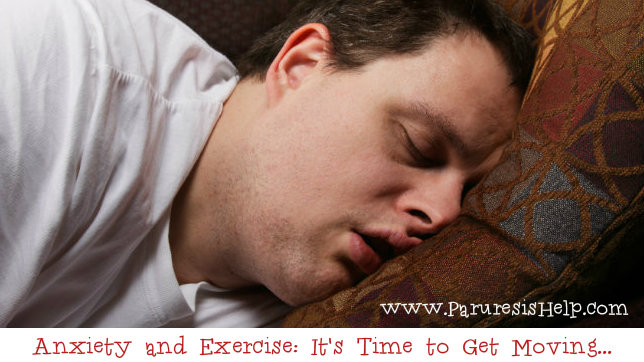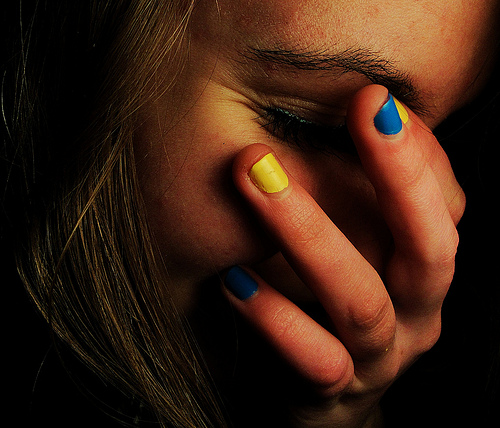
You sit in your car getting to work, where you continue to sit at your desk in front of a computer screen. By the time you get home after a long, tough day or the weekend hits, all you want to do is unwind by sitting on the couch in front of the TV. Sound familiar?
Americans are more inactive than ever, thanks to modern conveniences that encourage us to, well, sit around. All this sitting around increases our risk of obesity, heart disease, anxiety and related mental health woes. On the upside, you can do something about it. That something, as you may guess, is getting your butt off the couch!
Couch Potato Syndrome
The way our world is set up helps promote a widespread couch potato syndrome. A report produced by the Transportation Research Board and the Institute of Medicine Committee on Physical Activity, Health, Transportation, and Land Use found that modern conveniences and job types have helped caused adult activity levels to plummet.
While the trend for leisure-time physical activity has remained level or even slightly increased over a 50-year period, the overall amount of physical activity has been on the wane while sedentary activity has been on the rise. Work-related activity is going down, as it transportation activity and activity in the home. Lengthy commutes play a huge part in the transportation category, especially for suburbanites who travel long distances to cities for their jobs.
The report concluded that “the majority of the American population [is] at high risk of physical inactivity.” And we already know that means at an equally high risk of physical and mental woes. Kids are feeling it, too.
“Time once spent on physical or outdoor activity has been replaced by television, computer and video game time,” the Coalition for Healthy Children notes. At the same time, anxiety and depression rates in kids have been on the rise for the past 50 to 70 years, according to Psychology Today.
San Diego State University professor and anxiety researcher Jean Twenge, Ph.D., says the trend also applies to adults. “Anxiety rates have risen steadily over the past seven decades, during good economic times and bad.” Television began to hit the American living room scene in the 1950s, offering a very acute coincidence that may not be a coincidence at all.
Anxiety-Ridden Couch Potatoes
A study published in a 2006 issue of Preventive Medicine aimed to determine whether regular exercise has any bearing on anxiety, depression and personality. Guess what? It did.
The study took a large cross-section of the population and gauged their exercise habits in relation to their mental health over an 11-year period. The first result of note was that exercise declined dramatically from adolescence to adulthood, with 70 percent of adolescents engaging in exercise compared to only 30 percent of adults.
A subsequent result was perhaps even more noteworthy.
Exercisers were on average less anxious, depressed and neurotic, more extraverted and were higher in dimensions of sensation seeking than non-exercisers. These differences were modest in size, but very consistent across gender and age.
In other words, regular exercise not only makes you more inclined to socialize, look for exciting things to do that create sensory pleasure, but it can lower neuroticism, depression and anxiety. Now are you ready to get off the couch?
Intense Activity for Intense Anxiety
Another study concurred that aerobic exercise at any intensity level can help reduce anxiety, but it went one step further. The study, published in the February 2004 issue of Behaviour Research and Therapy, analyzed the results of high-intensity exercise on higher levels of anxiety, or levels that can easily result in fear of anxiety symptoms, panic attacks or even panic disorder. By golly, high-intensity exercise worked to bring that level down.
Fifty-four study participants with elevated anxiety took the treadmill for six 20-minute sessions. One group kept up a low-intensity walking pace while the others took a high-intensity run or jog. Those who went the high-intensity route reported a more rapid reduction of anxiety as well as freedom from the fear of anxiety-related bodily sensations, such as rapid breathing, sweaty palms and elevated heart rates. Jog on!
What Anxiety Does to Your Body
In its simplest terms, anxiety is a form of stress. A lot of it is based on worries for the future, with worries that can be rational, irrational or have no chance of happening in a zillion years. Perhaps you fear your marriage will end in divorce but you aren’t even dating anyone.
Even if the worry may seem ridiculous or illogical, the effects of anxiety on the body are quite real. Anxiety hits with a hard punch to the nervous system, setting off the biological alarm system we have that was designed to protect us danger. You’re probably familiar with the system’s nickname of the fight-flight response.
The rush of adrenaline and stress hormones that sluice through your body during this process is preparing you to face the danger by either fighting it or running for the hills. While this serves you well when confronted by something like, say, an attacking grizzly bear, it’s not as useful when you’re in your car on the way to work with no bears anywhere near the highway.
Physical symptoms include shaking and trembling, sweaty palms, a racing heart, difficulty breathing and dizziness. The brain reacts just as quickly, typically flooded with fear, until the cortex has a chance to assess the situation. The cortex is where your thinking takes place, sometimes far from your biological reactions and sometimes even farther from reality.
If the cortex perceives a real danger, the body continues its flow of adrenaline to help us fight or flee as the case may be. If the cortex perceives no threat, it sends a signal to deactivate the alarm system, the nervous system calms down and you go about your merry way. The problem arises, however, when things that are not truly a threat in reality appear as a threat to your mind.
What Exercise Does to Your Body
Exercise can help control the stress that shows up as anxiety, or any stress at all for that matter. One theory says exercise stimulates the neurotransmitters in the brain that work to elevate mood and sooth emotions. While the American Council on Exercise points out this particular theory has never been proven, it does say there is no dispute that exercise can help alleviate stress and, therefore, anxiety.
The movement reduces nervous tension and anxiety in your muscles. It also induces your body to send out a relaxation response in the form of seemingly magical brain chemicals known as endorphins. Endorphins double as natural painkillers and can improve sleep, soothe your mood, alleviate stress, decrease tension and give your self-esteem a boost. That relaxation response can work directly against the fight-flight response of anxiety, neutralizing tension and fear.
Exercise as an overall health booster is nothing new, nor is its known benefits for mental health issues. A Public Health Report article published way back in 1985 proclaimed the big impact of a little moving around. Exercise was shown to help alleviate the symptoms of anxiety and depression as well as boost self-image, cognitive functioning and social skills.
Added bonuses of exercise included being an effective supplement in the treatment of drug abuse, alcoholism and negative responses to stressors. Don’t reach for that drink, reach for that barbell!
The Centers for Disease Control and Prevention recommends adults get 2 hours and 30 minutes of moderate-intensity aerobic activity per week, or a total of 150 minutes, combined with muscle-strengthening activities at least twice per week.
You can achieve the former with five 30-minute sessions over seven days and the latter by picking activities like swimming or weight lifting that work every major muscle group. Many pedometer-oriented walking programs recommend adults hit at least 10,000 steps per day.
While 150 minutes of exercise per week is the recommended dose, you can begin to reap the anti-anxiety effects in as few as five minutes of aerobic activity, according to the Anxiety and Depression Association of America.
Exercise vs. Traditional Mental Health Treatments
Traditional modes of treatment for anxiety typically consist of therapy, medication, or a combination. Throw in exercise and you may have a no-fail triad that helps kick anxiety to the curb. Does that also mean exercise is an effective enough treatment to cancel your therapy and medication? Not necessarily.
While exercise has been helpful for anxiety and depression, it is most useful on its own for mild or moderate levels of such issues. A 2011 study published in the International Journal of Psychiatry in Medicine found exercise worked as well as a primary treatment for mild to moderate depression as well as a number of anxiety disorders.
Exercise also proved to be a great supplement to medication in an overall treatment plan but not as powerful at reducing severe anxiety as psychopharmaceuticals can be. Don’t chuck that bottle of medication just yet, but do get out and get moving.
How to Sneak Exercise into Your Daily Life
First off, perhaps you don’t want to think of it as “exercise,” which can bring up images of sweating, straining and not having much fun. Instead envision it as “me-time,” “playtime,” or even “time to get a free and legal endorphin high.”
Secondly, recruit a buddy. You’ll be more inclined to engage in physical activity if you make a commitment with a friend, coworker or neighbor. This doesn’t mean you have to devise an elaborate 22-part exercise plan that neither of you have the time or wherewithal to follow. It can mean grabbing a neighbor for a morning jog, a coworker for a lunch-break walk, or a pal for Saturday morning yoga classes.
A third trick is to be tricky about it. Taking the stairs instead of the elevator is one sneaky tactic. Another is parking farther from the mall entrance than usual. Leave your car at home and walk to the store if your errands are lightweight and nearby. Take a relaxing stroll around the neighborhood instead of plopping yourself, once again, in front of the computer or TV screen.
One more trick is to go for activities you find stimulating and fun. Take your pick from the list below or create your own variations. Although your overall goal is to engage in an activity for at least 150 minutes per week, you can break it down into much smaller segments until this exercise-as-a-way-of-life thing becomes as natural as, say, flipping on the computer or TV.
3 Easy Exercise Ideas
Make walking a game. Pedometers can do much more than help researchers perform studies. They provide great motivators for ensuring you get adequate activity throughout your day. They can also be as fancy or simple as you wish. Some can be synced with your computer to help create an overall walking plan and reach your fitness goals. Others come with calorie counters, clocks, lights and various other features. The least expensive just keep track of your daily step count and leave it at that. You can start with the recommended 10,000 steps then reward yourself for days you achieve even more. Reward yourself with something that makes you feel good, like a day at the spa or massage.
Play with your dog – or friends. Instead of trying to turn exercise into a game, you can just as easily play a game that automatically gives you exercise. Dogs can be great for this, especially if you have one that digs chasing a ball. You can rack up hundreds, or even thousands of steps romping about with your pooch at the park. Exercise-happy games to play with friends can include volleyball at the beach, racquetball at the local YMCA, or regular hula hoop or basketball competitions with your most competitive pal. The more vigorous the movement, the more effective it is at flushing out adrenaline and other stress-causing hormones. Check out your local recreation center to see what types of courts or even lessons may be available for you and your friends.
Go gaga for yoga. Yoga’s benefits are immense, and you can adapt your practice to fit your specific fitness and agility levels. Ever wonder what those yoga blocks were for? They help amend poses to meet your needs. Join a class or pick up a few yoga DVDs to do at home. Yoga works large muscle groups that, when contracted and relaxed, signal the brain to send out certain neurotransmitters that induce relaxation and alertness. Yoga also gives you a triple dose of exercise by working on your body, you mind and your soul.
SOURCES:
- http://web4.uwindsor.ca/users/f/fsirois/personality.nsf/0/c6247d71a3e97a4485257261005da15b/$FILE/Moor_PM_2006.pdf
- http://onlinepubs.trb.org/onlinepubs/archive/downloads/sr282papers/sr282Brownson.pdf
- http://www.cdc.gov/physicalactivity/everyone/guidelines/adults.html
- http://www.msnbc.msn.com/id/39335628/ns/health-mental_health/t/why-are-anxiety-disorders-among-women-rise/#.UIWIO8XO2xU
- http://www.sciencedirect.com/science/article/pii/S0005796703001037




